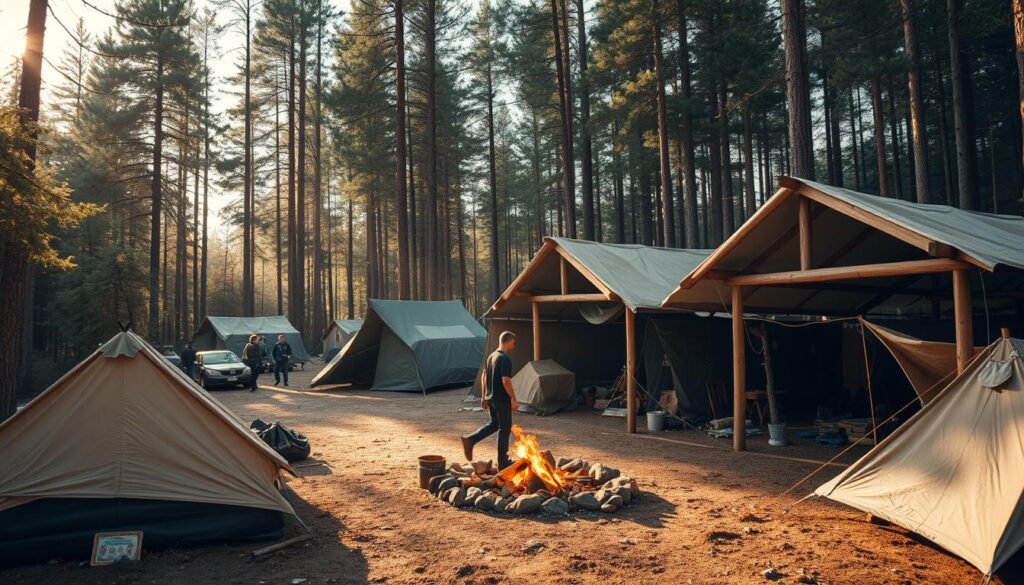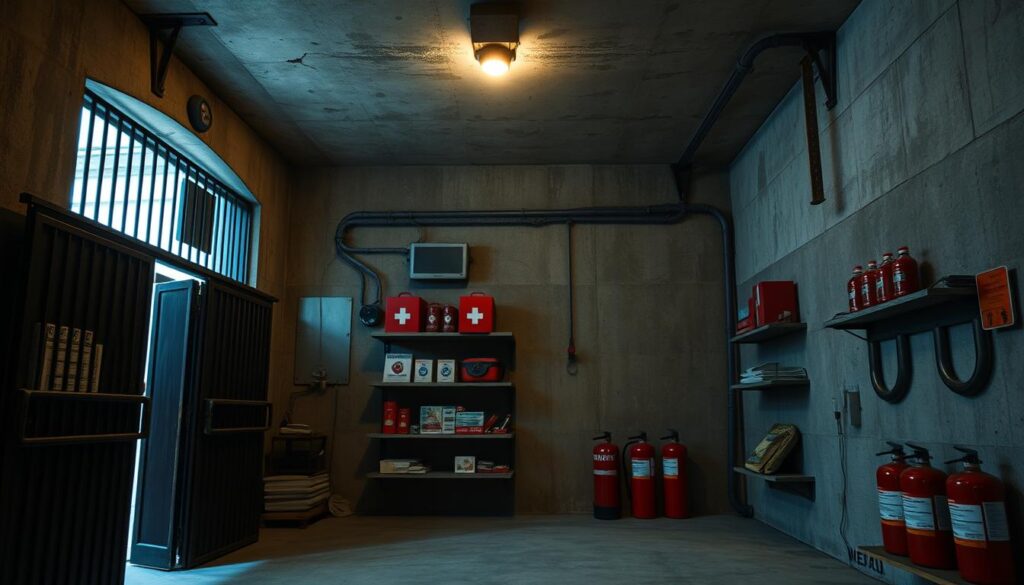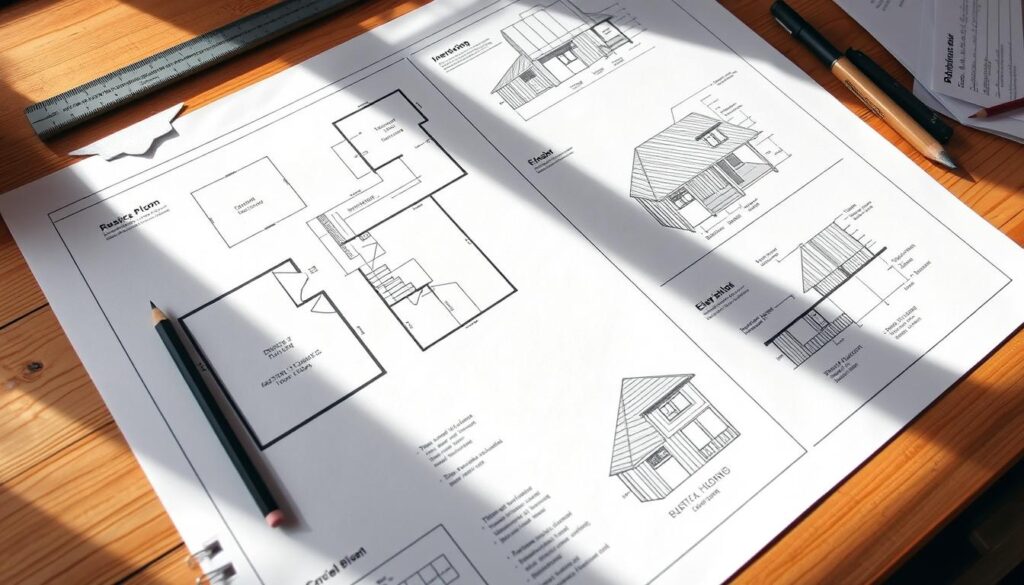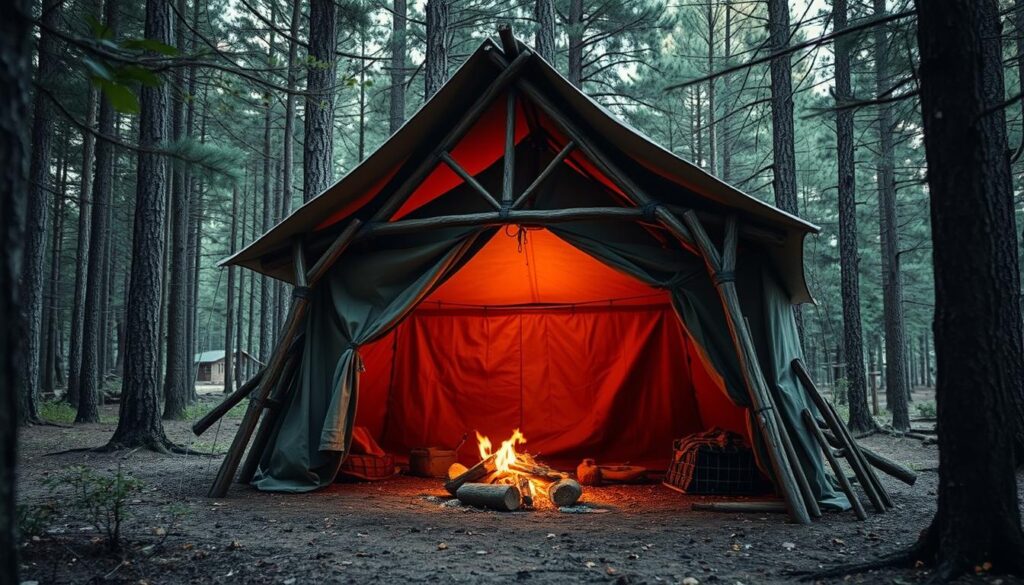Reflecting on my journey to build a safe place, I see how important a good shelter plan is. It’s key whether you’re facing a natural disaster or an unexpected event. A solid emergency shelter design can save your life.
Experts say building a shelter needs careful planning. You must think about local laws, design, and budget. I learned that making a detailed DIY shelter blueprint is vital. It makes sure your shelter is safe and works well.
Key Takeaways
- Understand local regulations before building a shelter
- Consider environmental factors in your design
- Choose the right materials for your shelter
- Ensure your shelter is compliant with local building codes
- Plan for emergency situations with a well-designed shelter
Understanding the Importance of Shelter Plans
Shelter planning is key in disaster management, yet often ignored. As I explore emergency preparedness, I see how vital a good shelter plan is. It’s essential for keeping people and property safe.
A solid shelter plan offers a safe place during emergencies. It guards against dangers like hurricanes, earthquakes, and floods. Shelter plans are not just for emergencies; they’re also vital for recovery efforts.
Why Every Builder Needs A Shelter Plan
For builders, a shelter plan is not just a good idea; it’s a must. It prepares them for the unexpected, making sure buildings can face natural disasters. By focusing on shelter planning, builders can build safe, strong structures.
Also, a shelter plan helps builders follow local rules and codes. This avoids expensive fines and project delays.
Key Components of Effective Shelter Plans
Good shelter plans have several important parts, like design, materials, and use. When making a shelter plan, think about size, style, and how many people it will hold. Also, consider local codes, the environment, and area risks.
By knowing these parts and adding them to the plan, builders can make structures that are safe, sustainable, and strong.
Types of Shelter Plans to Consider
Shelter plans fall into two main categories: emergency shelters and permanent structures. Knowing these categories helps you choose the right shelter for your needs.

Emergency Shelters: What You Need to Know
Emergency shelters offer quick protection during disasters or crises. They are fast to set up and can be made from tents or prefabricated units. For more on emergency preparedness, check out https://www.ready.gov/shelter.
Emergency shelters are known for:
- Rapid deployment
- Temporary or semi-permanent structures
- Basic amenities
Permanent Structures vs. Temporary Solutions
Permanent shelters are built to last, using materials like wood, steel, or concrete. Temporary shelters, on the other hand, are flexible and can be moved or taken down easily.
Comparison of Permanent and Temporary Shelters
| Characteristics | Permanent Shelters | Temporary Shelters |
|---|---|---|
| Construction Material | Durable materials (wood, steel, concrete) | Lightweight materials (tents, prefabricated units) |
| Duration | Long-term | Short-term or temporary |
| Cost | Generally higher upfront cost | Lower initial cost |
Choosing between permanent shelter designs and temporary shelter solutions depends on your needs, budget, and how you plan to use the shelter.
Steps to Create Your Own Shelter Plan
A shelter plan is more than a blueprint; it’s a roadmap to safety. To make an effective shelter plan, you need to follow several key steps. These steps ensure your shelter is safe and works well.
Conducting Site Assessments
The first step is to do a thorough site assessment. You need to look at the land where you plan to build. Consider the terrain, climate, and environment. This helps find the best spot for your shelter, keeping it safe and easy to reach when needed.
John Smith, a well-known disaster relief expert, said, “Knowing your site is key to building a shelter that can handle the weather.” This shows how important a detailed site assessment is in designing shelters.
Defining Your Shelter Needs
After assessing your site, you need to figure out your shelter needs. Think about the shelter’s size, purpose, and how many people it will hold. Your needs will guide the shelter design, affecting choices on materials, layout, and features.
A shelter for emergencies will differ from a permanent home. A leading architecture firm said, “A successful shelter matches its design with the needs of its users.” This matching is key for a shelter that works well and is efficient.
To clearly define your shelter needs, think about these factors:
- The shelter’s purpose (emergency, temporary, permanent)
- The number of people it will hold
- The amenities and features needed
- The budget for the project
By carefully checking your site and figuring out your shelter needs, you can make a plan that fits your situation. This ensures a safe and secure place for those who will use it.
Provisions for Safety and Security
Safety and security are key in any shelter plan. It’s important to make sure your shelter is safe from different dangers. This keeps everyone inside safe and sound.
Fire safety is a big deal. It’s not just about following rules; it’s a must for keeping people safe. Using fire-resistant materials and designing for easy escape are important. A good plan can help avoid injuries or deaths in fires.
Fire Safety Measures in Shelter Plans
Using materials that don’t catch fire easily is a must. Think about concrete, certain steels, and treated woods. The shelter’s layout should also help people get out fast. This means clear exit signs and easy-to-open doors and windows.
Having a security plan is also key. Regular checks on fire gear, smoke detectors, and electrical stuff are important. These steps help lower fire risks a lot.
Ensuring Structural Integrity
Structural integrity is just as important as fire safety. The shelter needs to handle wind, snow, and earthquakes well. It must be strong enough to hold everyone and their stuff.

Choosing the right materials and foundation design is critical. For example, earthquake-resistant designs are needed in quake-prone areas. High-wind areas need strong anchoring to resist wind.
By focusing on fire safety and structural integrity, you make a safe and lasting shelter. This approach meets building codes and keeps everyone safe.
Environmental Considerations for Shelter Plans
When planning shelters, it’s vital to think about the environment. A shelter is more than a safe place; it must also be sustainable and strong against natural disasters.
The decisions we make early on affect the environment a lot. This includes the materials used and how well the shelter can handle bad weather. So, we must think about the environment in every part of the planning.
Choosing Sustainable Materials
Choosing sustainable materials is a big deal. Materials that last long, can be recycled, and are local help reduce harm to the environment. For example, using old wood or special concrete cuts down on resource use.
| Material | Sustainability Features | Environmental Impact |
|---|---|---|
| Reclaimed Wood | Recyclable, Durable | Low |
| Low-Carbon Concrete | Reduced Carbon Emissions | Moderate |
| Locally Sourced Timber | Reduced Transportation Emissions | Low |
Planning for Natural Disasters
It’s also key to plan for natural disasters. We need shelters that can handle earthquakes, hurricanes, and floods. This means using strong materials, designing for wind, and setting up early warning systems.
- Use reinforced foundations to resist earthquakes.
- Design shelters with aerodynamic shapes to reduce wind resistance.
- Implement flood-resistant construction techniques in flood-prone areas.
In short, making environmental considerations a part of shelter plans is both right and smart. By picking eco-friendly materials and planning for disasters, we can build shelters that are safe and good for the planet.
Budgeting for Your Shelter Project
Knowing the money needed for a shelter project is key to its success. A good budget helps use resources well. This ensures the project is finished on time and within budget.
When budgeting, several things need to be considered. First, figure out the total project cost. This includes materials, labor, and permits. It’s important to get quotes from suppliers and contractors for an accurate estimate.
Estimating Costs and Expenses
Estimating costs means breaking down the project into parts and pricing each. This includes materials, labor, and other costs like permits and inspections. A detailed breakdown helps find ways to cut costs without lowering quality.
For a better estimate, talk to professionals who know about building shelters. They can offer insights and help make a more realistic budget.

Finding Funding Options
After getting a total cost estimate, look for funding options. You can get grants, loans, or use crowdfunding. Grants are great because they don’t need to be paid back, but they have rules.
Loans are another option, but you’ll need to repay them. Make sure to understand the loan terms, like interest rates and repayment periods. Crowdfunding can also help, for projects that involve the community.
By carefully estimating costs and looking at different funding options, you can make a detailed budget. This will help your shelter project succeed.
Legal Requirements and Permits
Following legal rules and getting the right permits are key to a successful shelter project. As we explore shelter construction, it’s clear that following legal standards is vital. It’s not just a formality, but a critical part of the project’s success.
Building codes and local rules are the foundation of legal needs for shelter projects. These rules ensure structures are safe, last long, and meet community standards. Understanding building codes is essential. They dictate what materials to use and how to build.
Understanding Building Codes
Building codes are detailed rules for designing, building, and using buildings. They aim to protect public health, safety, and welfare. For shelter projects, knowing these codes is key to avoid costly mistakes or legal problems later.
“Building codes are not just about compliance; they’re about creating safe and sustainable structures that serve their purpose effectively.” – Expert in Building Regulations
To handle building codes well, it’s important to:
- Get familiar with local building codes and updates.
- Seek advice from local building authorities or experts.
- Make sure your project follows code rules from the start.
Navigating Local Regulations
Local rules can have a big impact on a shelter project, just like building codes. These rules include zoning laws, environmental rules, and health standards. To deal with these rules, you need to know local laws well and be proactive about following them.
| Regulation Type | Description | Impact on Shelter Projects |
|---|---|---|
| Zoning Laws | Dictate how land can be used and what structures can be built. | Directly affects the location and design of shelter projects. |
| Environmental Regulations | Regulate the environmental impact of construction. | Impacts material choices and construction methods. |
| Health Standards | Ensure that buildings are safe for occupancy. | Affects the design and maintenance of shelters. |
To handle these rules well, work closely with local authorities and experts. This ensures your shelter project meets all legal needs.
By following legal rules and permits, your shelter project will be successful, sustainable, and safe for its users.
Collaborating with Professionals
Good shelter planning is more than just a design. It needs teamwork with experts. Working with skilled people is key to making your shelter real.
Teaming up with pros makes sure your shelter works well and is safe. You’ll likely work with architects and contractors. They each play a big part in planning your shelter.
When to Consult an Architect
An architect checks your shelter project. They make sure it looks good and works well. You should talk to an architect when:
- You need help with the initial design and layout of your shelter.
- You want to ensure that your shelter complies with local building codes and regulations.
- You are looking for innovative solutions to specific design challenges.
Architects offer great advice on space use, material choice, and meeting your needs.
The Role of Contractors in Shelter Planning
Contractors turn your shelter plans into a real building. Their job is to make sure the building goes up smoothly and right. They follow your plans and specs.
When working with contractors, remember to:
- Clearly communicate your expectations and requirements.
- Ensure they have the necessary experience and qualifications for your project.
- Establish a clear understanding of the project timeline and budget.
Working well with contractors helps avoid problems. It makes sure your shelter lasts a long time.
Reviewing and Revising Your Shelter Plans
To make sure a shelter plan works well, it’s key to check and update it often. This means looking at how well the plan can change and listening to what different people say. It’s all about making the plan better over time.
The Importance of Adaptability
Being able to change is very important in shelter planning. It lets the plan handle new situations and unexpected problems. A plan that can adapt well can face natural disasters and other big challenges better.
Having plans for different situations makes the shelter stronger. It’s about being ready for emergencies and being able to change the shelter’s setup as needed.
Seeking Feedback from Stakeholders
Getting feedback from people involved is very important. This includes users, builders, and local officials. Feedback from stakeholders can show what needs to be fixed or improved. Users can tell us how easy the shelter is to use, and builders can say if the design is doable.
To get good feedback, we need to talk to stakeholders in many ways. This means having meetings, doing surveys, and holding public talks. It helps us get a lot of opinions and make sure the plan is good and works well.
- Identify key stakeholders and their roles
- Establish clear communication channels
- Incorporate feedback into the shelter plan
By regularly checking and updating the shelter plan, we can make it strong, effective, and meet the needs of its users.
Moving Forward with Your Shelter Project
As I near the end of my shelter plan, it’s time to think about the last steps. I need to get the right permits and do inspections to follow local building codes. For more tips on making your home safe, check out disaster-proofing strategies online.
Pre-Construction Preparations
Before starting, I need to make sure everything is ready. This means checking my plans, materials, and who will help build it. I have to confirm the timeline, budget, and who will work on it.
Maintenance for Long-Term Shelter Completion
After my shelter is built, keeping it in good shape is key. I’ll do regular checks, fix things, and keep it clean. This way, my shelter will stay safe and strong for many years, making sure my project is a success.
FAQ
What is the importance of having a shelter plan?
Having a shelter plan is key. It gives you a safe place during emergencies. A good shelter plan can save lives in disasters.
What are the different types of shelter plans available?
There are many types of shelter plans. You can choose from emergency shelters, permanent structures, or temporary solutions. The right choice depends on your needs and the environment.
How do I create a shelter plan?
To create a shelter plan, start by assessing the site. Then, define your shelter needs. Choose the right materials for your design.
Consider the size, style, and purpose of your shelter. This will help you design a functional space.
What are the key components of effective shelter plans?
Good shelter plans follow local rules, have a solid design, and fit your budget. Make sure your shelter is safe from fires and strong. Use materials that are good for the environment.
How do I ensure compliance with local regulations?
To follow local rules, learn about building codes and zoning laws. Get the right permits before you start building.
What are the benefits of collaborating with professionals in shelter planning?
Working with experts like architects and contractors is helpful. They ensure your shelter is well-designed and meets all rules. They bring valuable knowledge to your project.
How do I budget for my shelter project?
To budget for your shelter, estimate costs for materials, labor, and permits. Look for funding options like grants, loans, or crowdfunding. This will help support your project.
What are some tips for maintaining my shelter after completion?
Keep your shelter in good shape with regular checks and repairs. This ensures it stays safe and secure over time.
How do I choose the right materials for my shelter?
Pick materials that last long, resist environmental dangers, and are eco-friendly. Make sure they also meet local building standards.
What are some strategies for planning for natural disasters?
Design your shelter to withstand wind, earthquakes, and other hazards. Think about the risks in your area and plan your shelter design wisely.
Why is adaptability important in shelter planning?
Adaptability is key because it lets you adjust to new conditions and needs. Regularly review and update your plan to stay effective.
How do I review and revise my shelter plan?
Get feedback from users, contractors, and local officials. Be open to suggestions and make changes as needed. This ensures your shelter plan meets your goals.



